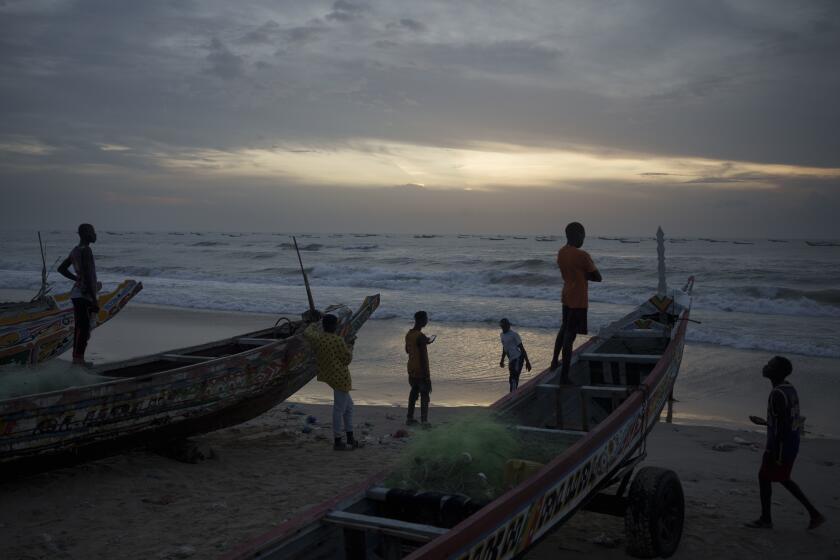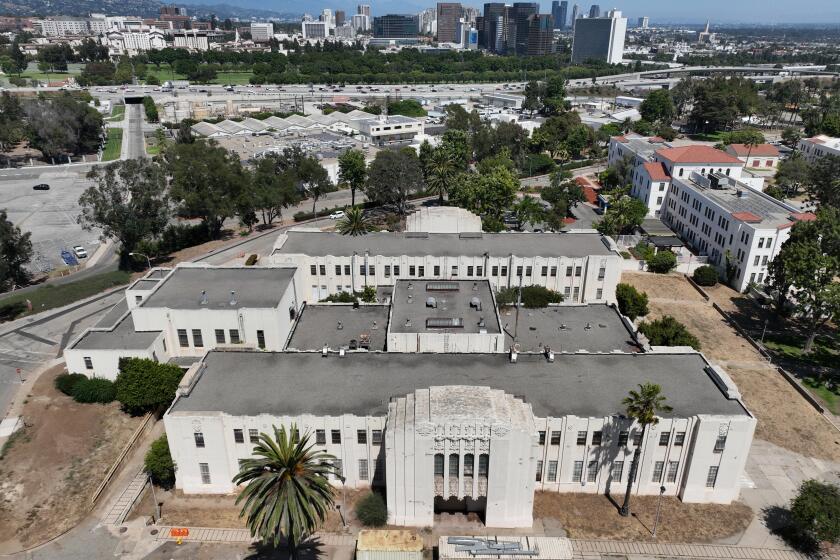650 Detainees Protest at Mira Loma Center
A six-hour demonstration by hundreds of detainees imprisoned in Lancaster ended without incident Monday after negotiators pledged to speed up bogged-down deportation proceedings.
As many as 650 inmates participated in the largest protest ever staged at the Mira Loma Detention Center. Many flung bright orange prison clothing and trash onto razor-wire fences, while others unfurled bedsheet banners and yelled to spectators, demanding they be deported or released on bond.
Demonstrators said many have been held for months in a facility where tensions have been described as “a time bomb waiting to go off.”
Snagged clothing flapped in a stiff wind as protesters stood about in a prison yard, refusing to return to their beige military-style barracks.
Inmates told reporters that television and phone services were cut off shortly after the protest began at 10:30 a.m. But Los Angeles County Sheriff’s deputies said those privileges were never taken away.
About 240 demonstrators remained when the protest ended shortly after 4 p.m., after talks between protesters and representatives of the Immigration and Naturalization Service, state Department of Corrections and Los Angeles County Sheriff’s Department.
“It’s over,” announced Assistant Sheriff Larry L. Waldie as he walked out the gates. “The situation is over here. The needs of the inmates have been met.”
One of the demands granted was that detainees be allowed to speak to the media about their long-standing complaints about the slow pace of deportation proceedings.
Mira Loma, which has been used for detainees for more than two years, currently houses 869 inmates, almost half from Mexico the rest from 40 other countries.
The INS has been negotiating with the sheriff’s department to house more than 1,000 prisoners in the expansive Mira Loma facility, but the agency does not yet have the funding to increase its detained population there.
Spectators at Mira Loma on Monday included relatives of inmates who said they received phone calls over the weekend from family members complaining that they lack shoes and adequate clothing and that personal items such as toothbrushes were taken from them. Graziella Esparza of North Hollywood said her son scribbled her a note saying in part he had been kept for three days in temperatures below 40 degrees, without a jacket.
The INS is increasingly facing a detention crunch nationwide, as Congress requires the agency to hold virtually all foreign nationals facing deportation who have criminal records--”criminal aliens,” in government parlance. The soaring rate of immigration-related detention is rising much faster than the overall increase in incarceration nationwide in local, state and federal jails.
One recent complication that may have aggravated delays, the INS said, is that the agency suspended deportations of most Central Americans for almost four months as a humanitarian gesture following Hurricane Mitch in November. That action led to protests by Central Americans in custody at Mira Loma and other facilities used by the INS, who preferred to be deported rather than being stuck in INS custody.
Deportations of most Central Americans resumed March 8, but by then a substantial backlog had grown, along with frustrations.
About 60% of all INS prisoners nationwide are being held in local facilities, typically county jails like Mira Loma. The INS simply does not have enough space in its own lockups--or contract facilities run by private firms under INS aegis--to house its rapidly expanding population of prisoners. So the agency rents space from Los Angeles County and scores of other counties, parishes, cities and other jurisdictions nationwide.
“We would prefer to house all INS detainees in facilities owned and operated by the INS, but the infrastructure to do that does not exist; and the rapid buildup of detention, within a brief period of time, necessitates the use of outside facilities,” said Russell Bergeron, an INS spokesman in Washington.
Currently, the INS has about 16,400 prisoners nationwide, more than triple the number held in 1994. Of those, 76% have criminal records and, under current law, must be detained until deported, Bergeron said.
Until 1996, however, many INS prisoners with criminal records could qualify for release on bond or other circumstances if they were judged not to be a threat to society. But lawmakers and others complained that many fled while awaiting deportation and disappeared into the general population.
Seeking to close that loophole, Congress in 1996 passed a so-called “mandatory detention” statute that forced the INS to hold virtually all detainees with criminal records. Congress delayed implementation for two years but declined last year to put it off again. Consequently, the INS in October finally lost most of its discretion to release detainees with criminal pasts--even those whose crimes were nonviolent and committed years or decades earlier.
“Clearly, this has forced us to use a vast amount of our overall detention space to hold mandatorily detained criminal aliens, and that exacerbates the fact that our budget restraints don’t leave us with the [detention] space we need,” Bergeron said.
INS officials acknowledge that delays plague the process, and that the long waits have stretched detention capabilities in Southern California.
“This concerns us but we’re pleased at how the Sheriff’s Department handled it, and we’re working on improving any or all of our processes to prevent the kind of overcrowding we have now,” said Rosemary Melville, the INS deputy district director in Los Angeles.
Times Staff Writer Martha L. Willman contributed to this story.
Sign up for Essential California
The most important California stories and recommendations in your inbox every morning.
You may occasionally receive promotional content from the Los Angeles Times.







